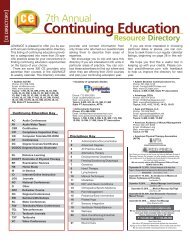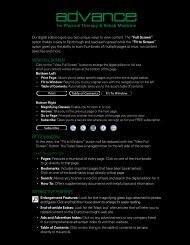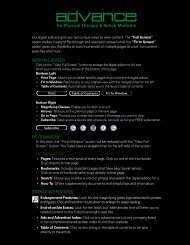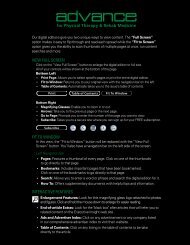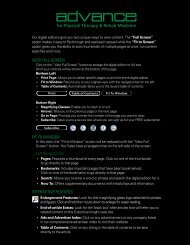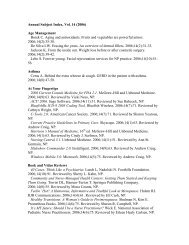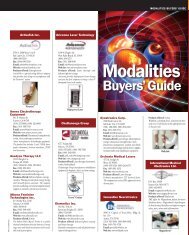Download - ADVANCE for Physical Therapy & Rehab Medicine
Download - ADVANCE for Physical Therapy & Rehab Medicine
Download - ADVANCE for Physical Therapy & Rehab Medicine
Create successful ePaper yourself
Turn your PDF publications into a flip-book with our unique Google optimized e-Paper software.
[BACK PAIN]<br />
and when it’s appropriate <strong>for</strong> the patient to move <strong>for</strong>ward or regress<br />
to another phase, is what makes a therapist competent.<br />
The main goal in the initial phase is to calm down inflammation of the<br />
tissue at fault as quickly as possible. The patient should not participate<br />
in any activities that would stretch the tissue more during this time.<br />
Activities that should be avoided include bending <strong>for</strong>ward and twisting,<br />
walking, sitting <strong>for</strong> long periods of time, stooping, lifting heavy objects<br />
with or without rotation, and participating in static activities that require<br />
the ligament to hold the spinal column <strong>for</strong> long periods.<br />
Having the patient lie on their stomach or back and using modalities<br />
such as ice (inflammation) and electrical stimulation will help calm<br />
down the overstretched and inflamed tissue. The McKenzie Method<br />
and/or Williams flexion-based exercises can put the back in a position<br />
to not overstretch or compress inflamed tissue.<br />
Active rest, such as walking, can help put the low-back tissue on<br />
slack as the patient strides through the walking motion <strong>for</strong> posterior<br />
ligamentous dysfunction. Isometric back exercises and Kegel pelvic<br />
floor exercises <strong>for</strong> the pelvic/sacral region while lying in the prone or<br />
supine position are great <strong>for</strong> getting the muscles firing again without<br />
putting any major load on the surrounding inflamed tissue. During<br />
this phase, it’s important that the patient adheres to this program<br />
at home on a continual basis. Compliance is the key to managing<br />
symptoms to progress through the first phase.<br />
The next phase should be focused on strengthening the back via<br />
isometric exercises in a standing position. Per<strong>for</strong>ming rhythmic stabilization<br />
exercises <strong>for</strong> the back and pelvic musculature in a standing<br />
position can be done using a physioball or other devices.<br />
The third phase of lumbosacral rehabilitation involves active resistive<br />
exercises in single plane positions such as sidebending, rotation,<br />
extension and flexion. This can be done using exercise bands, a medicine<br />
ball or free weights.<br />
The purpose of the fourth phase is to mimic functional movements,<br />
and prepare the patient <strong>for</strong> return to normal work-related and recreational<br />
activities. We usually use exercise bands, medicine balls and/or<br />
free weights while incorporating chop, lift, push and pull exercises to<br />
mimic functional activities. It is also important to incorporate diagonal<br />
movements during this phase, as this is what’s most common in our<br />
daily lives. During patients’ physical therapy regimens, we often incorporate<br />
stability exercises using a body blade, rocker boards, physioball,<br />
the BOSU ball, and other devices that challenge their balance and put<br />
stress on their core region.<br />
The fifth and final phase is optional <strong>for</strong> those wanting to return to<br />
high-level recreational activities. This is the time to per<strong>for</strong>m sport-specific<br />
exercises that produce the biggest load on the lumbosacral region.<br />
The Home Program<br />
Throughout the phases that involve resistance training, it is important<br />
that patients execute home programs appropriately. As you start to<br />
progress patients to more of a strengthening/stability regimen, do<br />
not get carried away with doing resistive exercises to the same region<br />
(lumbosacral) on a daily basis. Recovery throughout an aggressive<br />
training and rehabilitation regimen is nearly as important as the actual<br />
treatment itself.<br />
I usually require the patient to participate in a home program based<br />
on the amount of times he is being seen on a weekly basis in therapy. I<br />
back pain continued on page 46<br />
1. Helps stretched ligaments heal faster.<br />
2. Helps re-align and narrow pelvis after delivery.<br />
3. Significant pain relief has been clinically confirmed.<br />
Sold Worldwide For Pregnancy and Back Pain<br />
PATIENTS WITH FORWARD HEAD POSTURE?<br />
ANTERIORLY WEIGHTED 1-5 POUNDS<br />
<br />
<br />
<br />
<br />
PATIENTS WITH CERVICAL IMMOBILITY?<br />
ONE POUND PROPORTIONALLY BALANCED<br />
CERVICAL EXERCISE TOOL<br />
<br />
<br />
<br />
<br />
• Improves neurological<br />
function<br />
Halo Products are Patented and Manufactured by White Sky, LLC<br />
Contact@HaloRejuvenator.com<br />
888-884-4256(HALO)<br />
Like Us On Facebook &<br />
Receive Exclsuive Offers<br />
<strong>ADVANCE</strong> <strong>for</strong> <strong>Physical</strong> <strong>Therapy</strong> & <strong>Rehab</strong> <strong>Medicine</strong><br />
25



